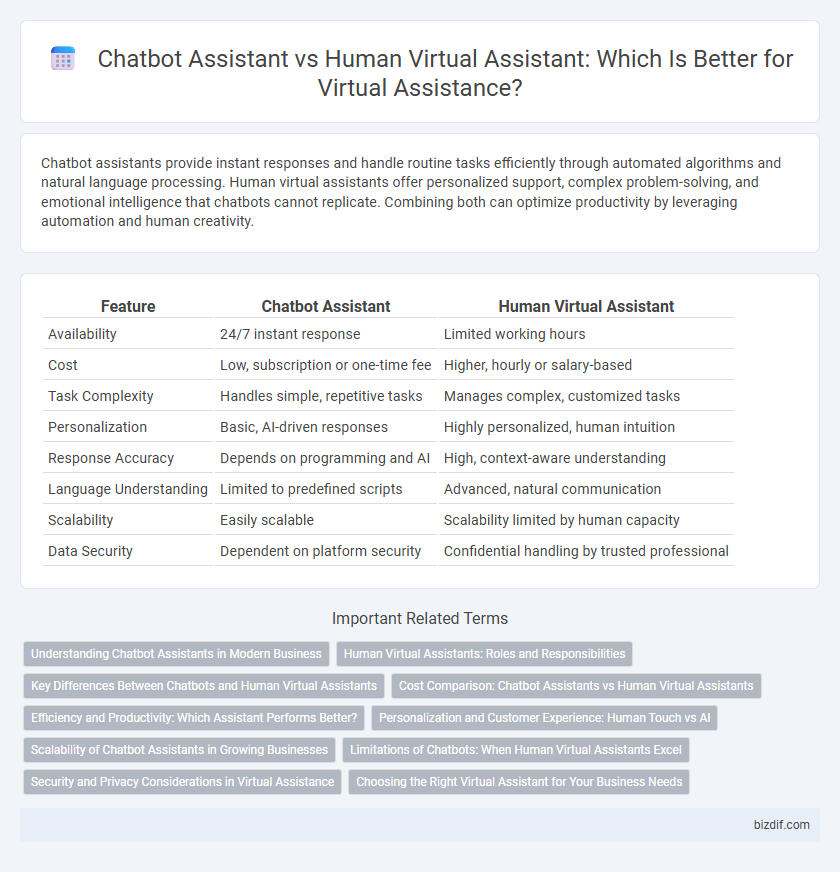Chatbot assistants provide instant responses and handle routine tasks efficiently through automated algorithms and natural language processing. Human virtual assistants offer personalized support, complex problem-solving, and emotional intelligence that chatbots cannot replicate. Combining both can optimize productivity by leveraging automation and human creativity.
Table of Comparison
| Feature | Chatbot Assistant | Human Virtual Assistant |
|---|---|---|
| Availability | 24/7 instant response | Limited working hours |
| Cost | Low, subscription or one-time fee | Higher, hourly or salary-based |
| Task Complexity | Handles simple, repetitive tasks | Manages complex, customized tasks |
| Personalization | Basic, AI-driven responses | Highly personalized, human intuition |
| Response Accuracy | Depends on programming and AI | High, context-aware understanding |
| Language Understanding | Limited to predefined scripts | Advanced, natural communication |
| Scalability | Easily scalable | Scalability limited by human capacity |
| Data Security | Dependent on platform security | Confidential handling by trusted professional |
Understanding Chatbot Assistants in Modern Business
Chatbot assistants leverage AI and natural language processing to provide instantaneous customer support and handle repetitive tasks efficiently in modern business environments. Unlike human virtual assistants, chatbots operate 24/7 without fatigue, reducing operational costs and increasing scalability for businesses. Their ability to analyze large data sets enables personalized interactions, enhancing customer satisfaction and driving business growth.
Human Virtual Assistants: Roles and Responsibilities
Human virtual assistants handle complex tasks such as managing schedules, conducting research, and providing personalized customer support that often requires emotional intelligence and critical thinking. Their responsibilities include organizing communications, coordinating projects, and adapting to dynamic business needs with a human touch. Unlike chatbots, human virtual assistants offer nuanced problem-solving and empathetic engagement, enhancing client satisfaction and operational efficiency.
Key Differences Between Chatbots and Human Virtual Assistants
Chatbot assistants operate based on pre-programmed algorithms and natural language processing, enabling instant responses to common queries but limited by scripted interactions and lack of emotional understanding. Human virtual assistants provide personalized support, adapt to complex tasks, and interpret nuanced communication, enhancing problem-solving capabilities and client relations. The key differences lie in adaptability, empathy, and the scope of problem resolution, with chatbots excelling in efficiency and humans in contextual judgment.
Cost Comparison: Chatbot Assistants vs Human Virtual Assistants
Chatbot assistants offer significantly lower operational costs due to their automation capabilities and 24/7 availability without the need for salaries or benefits. Human virtual assistants incur higher expenses, including wages, training, and employee benefits, leading to increased overall investment. Businesses seeking cost efficiency often prefer chatbot assistants for routine tasks while reserving human virtual assistants for complex, personalized interactions.
Efficiency and Productivity: Which Assistant Performs Better?
Chatbot assistants excel in handling repetitive tasks and providing instant responses, significantly boosting efficiency through automation and 24/7 availability. Human virtual assistants bring adaptability and nuanced understanding to complex tasks, enhancing productivity in scenarios requiring problem-solving and personalized interactions. When evaluating which performs better, organizations should consider task complexity and desired interaction quality to optimize overall operational efficiency.
Personalization and Customer Experience: Human Touch vs AI
Human virtual assistants provide personalized interactions through emotional understanding and empathy, enhancing customer satisfaction and loyalty. Chatbot assistants rely on AI algorithms to quickly process data and deliver consistent responses, improving efficiency but often lacking the nuanced human touch. Combining AI-driven chatbots with human oversight can optimize both personalization and customer experience, balancing speed with emotional connection.
Scalability of Chatbot Assistants in Growing Businesses
Chatbot assistants offer unparalleled scalability by handling thousands of customer interactions simultaneously without compromising response time or quality, making them ideal for growing businesses with fluctuating demand. Unlike human virtual assistants, chatbots can be easily integrated with CRM systems and automated workflows, enabling continuous availability and cost-effective expansion. Enhanced by AI and machine learning, chatbot assistants improve over time, delivering personalized support while managing increasing volumes efficiently.
Limitations of Chatbots: When Human Virtual Assistants Excel
Chatbot assistants often struggle with understanding complex emotions, nuanced language, and context-specific queries, which limits their effectiveness in providing personalized support. Human virtual assistants excel in handling ambiguous requests, adapting to unique client needs, and offering empathetic interactions that chatbots cannot replicate. Tasks requiring critical thinking, creativity, or emotional intelligence remain areas where human assistants consistently outperform AI-driven chatbots.
Security and Privacy Considerations in Virtual Assistance
Chatbot assistants employ encryption protocols and AI-driven anomaly detection to safeguard user data, yet they may lack the nuanced judgment of human virtual assistants in handling sensitive information. Human virtual assistants provide personalized privacy controls and discretion, benefiting from ethical training and contextual awareness to prevent data breaches. Both require rigorous security measures, but combining AI's rapid response with human oversight enhances overall privacy protection in virtual assistance.
Choosing the Right Virtual Assistant for Your Business Needs
Choosing the right virtual assistant involves evaluating the efficiency and personalization required by your business; chatbot assistants provide rapid responses and operate 24/7, ideal for handling repetitive customer inquiries and basic tasks. Human virtual assistants offer nuanced understanding, emotional intelligence, and adaptability, making them better suited for complex tasks, strategic planning, and customized client interactions. Assessing your business's workflow complexity and customer engagement goals will help determine whether an AI-driven chatbot or a human virtual assistant aligns best with your operational needs and growth plans.
Chatbot assistant vs Human virtual assistant Infographic

 bizdif.com
bizdif.com